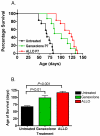Endogenous and synthetic neurosteroids in treatment of Niemann-Pick Type C disease
- PMID: 17629950
- PMCID: PMC2323675
- DOI: 10.1016/j.brainresrev.2007.05.012
Endogenous and synthetic neurosteroids in treatment of Niemann-Pick Type C disease
Abstract
The functions for neurosteroids during development and in response to nervous system injury are beginning to be identified. We focused on a mouse model in which we believed neurosteroid production would be altered, and which had a neurodegenerative phenotype. Niemann-Pick Type-C (NP-C) is an autosomal recessive neurodegenerative disease caused by mutations in NPC1 (95%) or NPC2 (5%), resulting in lysosomal accumulation of unesterified cholesterol and glycolipids. The NIH mouse model of NP-C has a mutation in the NPC1 gene, and exhibits several pathological features of the most severe NP-C patients. How lysosomal storage and trafficking defects lead to neurodegeneration is unknown. We found that these mice had normal neurosteroidogenic enzyme activity during development, but lost this activity in the early neonatal period, prior to onset of neurological symptoms. Neurons that expressed P450scc, 3beta HSD, as well as those that expressed 3alpha HSD and 5alpha reductase were lost in adult NP-C brains, resulting in diminished concentrations of allopregnanolone. We treated NP-C mice with allopregnanolone and found that a single dose in the neonatal period resulted in a doubling of life span, substantial delay in onset of neurological symptoms, survival of cerebellar Purkinje and granule cell neurons, and reduction in cholesterol and ganglioside accumulation. The mechanism by which allopregnanolone elicited these effects is unknown. Our in vitro studies showed that Purkinje cell survival promoted by allopregnanolone was lost by treatment with bicuculline, suggesting GABA(A) receptors may play a role. We treated NP-C mice with a synthetic GABA(A) neurosteroid, ganaxolone (3alpha-hydroxy-3beta-methyl-5alpha-pregnan-20-one). Ganaxolone treatment of NP-C mice produced beneficial neurological effects, but these effects were not as robust as those obtained using allopregnanolone. Thus, allopregnanolone may elicit its effects through GABA(A) receptors and through other mechanisms. Additional studies also suggest that allopregnanolone may elicit its effects through pregnane-X-receptors (PXR). Our data suggest that mouse models of neurodegeneration may be beneficial in establishing both physiologic and pharmacologic actions of neurosteroids. These animal models further establish the wide range of functions of these compounds, which may ultimately be useful for treatment of human diseases.
Figures




Similar articles
-
Niemann-Pick type C disease involves disrupted neurosteroidogenesis and responds to allopregnanolone.Nat Med. 2004 Jul;10(7):704-11. doi: 10.1038/nm1073. Epub 2004 Jun 20. Nat Med. 2004. PMID: 15208706
-
Allopregnanolone treatment delays cholesterol accumulation and reduces autophagic/lysosomal dysfunction and inflammation in Npc1-/- mouse brain.Brain Res. 2009 May 13;1270:140-51. doi: 10.1016/j.brainres.2009.03.027. Epub 2009 Mar 25. Brain Res. 2009. PMID: 19328188 Free PMC article.
-
Pregnane X receptor (PXR) activation: a mechanism for neuroprotection in a mouse model of Niemann-Pick C disease.Proc Natl Acad Sci U S A. 2006 Sep 12;103(37):13807-12. doi: 10.1073/pnas.0606218103. Epub 2006 Aug 29. Proc Natl Acad Sci U S A. 2006. PMID: 16940355 Free PMC article.
-
Allopregnanolone as regenerative therapeutic for Alzheimer's disease: translational development and clinical promise.Prog Neurobiol. 2014 Feb;113:40-55. doi: 10.1016/j.pneurobio.2013.08.004. Epub 2013 Sep 14. Prog Neurobiol. 2014. PMID: 24044981 Free PMC article. Review.
-
Revisiting the roles of progesterone and allopregnanolone in the nervous system: resurgence of the progesterone receptors.Prog Neurobiol. 2014 Feb;113:6-39. doi: 10.1016/j.pneurobio.2013.09.004. Epub 2013 Oct 27. Prog Neurobiol. 2014. PMID: 24172649 Review.
Cited by
-
Cerebellar Changes in Guinea Pig Offspring Following Suppression of Neurosteroid Synthesis During Late Gestation.Cerebellum. 2017 Apr;16(2):306-313. doi: 10.1007/s12311-016-0802-0. Cerebellum. 2017. PMID: 27255705
-
Neurosteroids and GABAergic signaling in health and disease.Biomol Concepts. 2013 Feb;4(1):29-42. doi: 10.1515/bmc-2012-0033. Biomol Concepts. 2013. PMID: 25436563 Free PMC article. Review.
-
Neuroprotective actions of neurosteroids.Front Endocrinol (Lausanne). 2011 Oct 11;2:50. doi: 10.3389/fendo.2011.00050. eCollection 2011. Front Endocrinol (Lausanne). 2011. PMID: 22649375 Free PMC article.
-
Alfaxalone anaesthesia increases brain derived neurotrophic factor levels and preserves postoperative cognition by activating pregnane-X receptors: an in vitro study and a double blind randomised controlled trial.BMC Anesthesiol. 2022 Dec 24;22(1):401. doi: 10.1186/s12871-022-01940-x. BMC Anesthesiol. 2022. PMID: 36564723 Free PMC article. Clinical Trial.
-
New therapies in the management of Niemann-Pick type C disease: clinical utility of miglustat.Ther Clin Risk Manag. 2009;5:877-87. doi: 10.2147/tcrm.s5777. Epub 2009 Nov 18. Ther Clin Risk Manag. 2009. PMID: 19956552 Free PMC article.
References
-
- Ahmad I, Lope-Piedrafita S, Bi X, Hicks C, Yao Y, Yu C, Chaitkin E, Howison CM, Weberg L, Trouard TP, Erickson RP. Allopregnanolone treatment, both as a single injection or repetitively, delays demyelination and enhances survival of Niemann-Pick C mice. J Neurosci Res. 2005;82:811–821. - PubMed
-
- Alakoskela JM, Covey DF, Kinnunen PK. Lack of enantiomeric specificity in the effects of anesthetic steroids on lipid bilayers. Biochim Biophys Acta. 2007;1768:131–145. - PubMed
-
- Anzil AP, Blinzinger K, Mehraein P, Dozic S. Niemann-Pick disease type C: case report with ultrastructural findings. Neuropadiatrie. 1973;4:207–225. - PubMed
-
- Backstrom T, Andersson A, Andree L, Birzniece V, Bixo M, Bjorn I, Haage D, Isaksson M, Johansson IM, Lindblad C, Lundgren P, Nyberg S, Odmark IS, Stromberg J, Sundstrom-Poromaa I, Turkmen S, Wahlstrom G, Wang M, Wihlback AC, Zhu D, Zingmark E. Pathogenesis in menstrual cycle-linked CNS disorders. Ann N Y Acad Sci. 2003;1007:42–53. - PubMed
Publication types
MeSH terms
Substances
Grants and funding
LinkOut - more resources
Full Text Sources
Other Literature Sources
Medical
Miscellaneous

